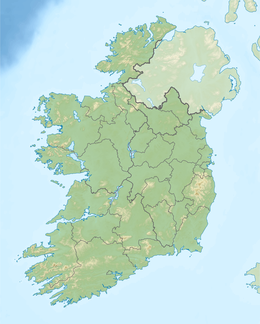Inchagoill
Native name: Inis an Ghaill Crabhthigh | |
|---|---|
 Landing point | |
| Geography | |
| Location | Lough Corrib |
| Coordinates | 53°29′10″N 9°19′01″W / 53.486°N 9.317°W |
| Area | 0.3268 km2 (0.1262 sq mi)[1] |
| Highest elevation | 24 m (79 ft) |
| Administration | |
| Province | Connacht |
| County | Galway |
| Barony | Ross |
| Demographics | |
| Population | 0 |
| Inchagoill | |
|---|---|
| Native name Inis an Ghaill Crabhthigh | |
| Built | 6th–12th century AD |
| Architectural style(s) | Romanesque |
| Owner | State |
| Official name | Inchagoill Early Medieval Ecclesiastical Site |
| Reference no. | 412 |
Inchagoill is an island in Lough Corrib, Ireland. Its Christian ruins constitute an Irish National Monument. The island name means "Island of the devout foreigner."[2]
Location[edit]
Inchagoill is an island of 32.68 ha (80.8 acres) located in the northwest part of Lough Corrib. It lies halfway between Oughterard and Cong. Burr Island (1.18 ha (2.9 acres)) lies immediately to the north.[3][4]
Ruins and monuments[edit]
St. Patrick's Church[edit]

Also called Templepatrick (Teampall Phádraig), its construction was traditionally attributed to Saint Patrick and his nephew Lugnad, who is credited with bringing him to Ireland by boat; it is more likely to date to the 6th or 7th century AD.[5]
Lugnad's stone[edit]

This stone, of Silurian grit and shaped like a rudder, bears the inscription Lia Lugnaedon Macc Limenueh ("Stone of Lugnad son of Limenueh", the latter being Patrick's sister Liamain; there are many variant readings). It is the oldest inscription in Ireland in the Latin alphabet (all earlier inscriptions are in Ogham).[6][7] The pillar is known as 'Lugnaedon Pillar', a piece of Silurian grit stone, about two feet high with an incised cross on the north side, and two such crosses on each of the other sides. The stone bears an inscription "Lie Lugnaedon Macc Li Menueh", translated, it means "The stone of Lugnaedon, son of Limenueh", the sister of St. Patrick. The pillar dates back to the 6th century. This pillar is the remains of an Ogham stone, and was sanctified with crosses after it was purged of its pagan inscription, by the founder of the church.
Templenaneeve[edit]

In Irish Teampall na Naoimh, "church of the saints."
A flagged path of 72 m (79 yd) in length connects the two churches. Templenaneeve is Hiberno-Romanesque church with a 12th-century decorated arched doorway; its sculpted heads are similar to those at Annaghdown Abbey.[8] The incised slab is 8th century, and there are three bullauns as well. The chancel is semi-circular and undecorated.[9][10][11]
Graveyard[edit]
The graveyard is also ancient; buried there is Muirgheas O'Nioc (Muirgius ua Nioc; died 1128), coarb of Tuam.[12] (He is often incorrectly described as Archbishop of Tuam, but that title didn't exist until 1152.)[13] Other important families in the region also used the graveyard: Kinnaveys, Conways, Sullivans, Murphys, Lyddans, Butlers.
Other sites[edit]
A holy well (Tobernaneeve), two cross-inscribed pillars and five cross slabs.[14]
Today[edit]
An annual Mass is celebrated on the island, and local cruise companies offer tourist expeditions to the island.[15][16]
Coillte have extensively afforested the island.[17]
References[edit]
- ^ From 6-inch OS map, which gives an area of 80 acres, 3 roods, 1 perch.
- ^ Macalister, R. A. S. (24 October 2014). Ancient Ireland: A Study in the Lessons of Archaeology and History. Routledge. ISBN 9781317602590 – via Google Books.
- ^ Halpin, Andy; Newman, Conor (26 October 2006). Ireland. OUP Oxford. ISBN 9780191513176 – via Google Books.
- ^ "Explanation to Accompany Sheets 1-". H.M. Stationery Office. 10 December 1871 – via Google Books.
- ^ "Inchagoill, Lough Corrib's Largest Island".
- ^ "Inchagoill Inscribed Pillar Stone".
- ^ Swift, Catherine (10 December 1997). Ogam Stones and the Earliest Irish Christians. Department of Old and Middle Irish, St. Patrick's College. ISBN 9780901519986 – via Google Books.
- ^ Hourihane, Colum (10 December 2017). From Ireland Coming: Irish Art from the Early Christian to the Late Gothic Period and Its European Context. Princeton University Press. ISBN 9780691088259 – via Google Books.
- ^ SiteCaddy. "Inchagoill Island - Oughterard Tourism". www.oughterardtourism.com.
- ^ "Inchagoill Island - Love Connemara".
- ^ Quinn, J. F. (1 January 1996). History of Mayo. Brendan Quinn. ISBN 9780951928028 – via Google Books.
- ^ "Part 23 of Annals of the Four Masters". celt.ucc.ie.
- ^ Murray, Griffin. "The establishment of Tuam as an archdiocesan capital in the twelfth century". Glimpses of Tuam Through the Centuries: Proceedings of a Seminar 28th September 2013 (Ed. A. Tierney).
- ^ "A Guide to Lough Corrib's Early Monastic Sites".
- ^ "Oughterard – Inchagoill – Cong Return". Corrib Cruises. 2 March 2017.
- ^ "Highly recommended visit to historic Inchagoill Island. - Review of Corrib Cruises, Cong, Ireland - TripAdvisor". www.tripadvisor.ie.
- ^ "Irish Forestry". 10 December 1997 – via Google Books.

